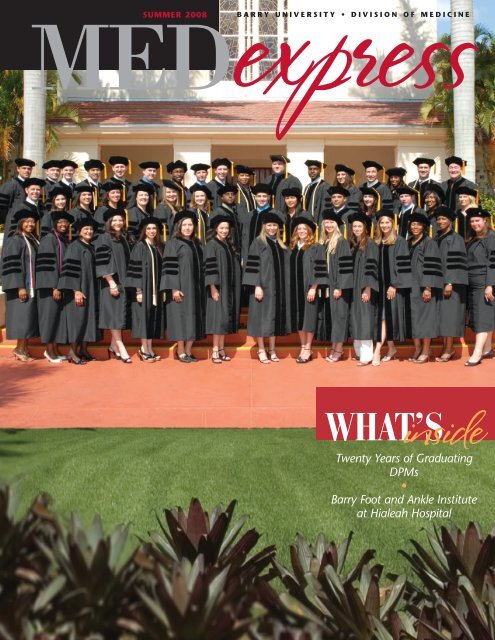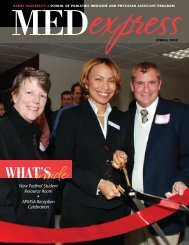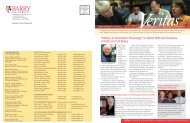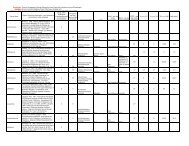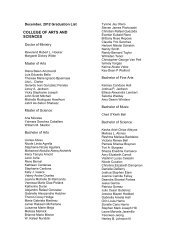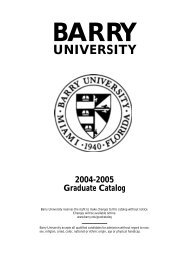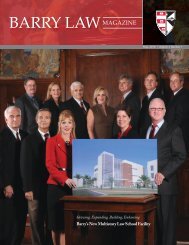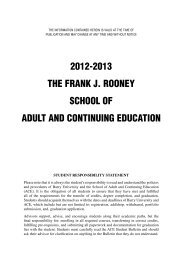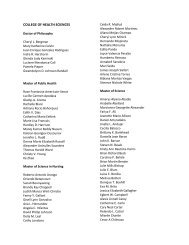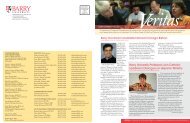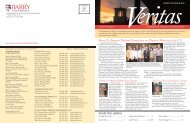WHAT'Sinside - Barry University
WHAT'Sinside - Barry University
WHAT'Sinside - Barry University
Create successful ePaper yourself
Turn your PDF publications into a flip-book with our unique Google optimized e-Paper software.
MEDexpress<br />
SUMMER 2008 BARRY UNIVERSITY • DIVISION OF MEDICINE<br />
WHAT’S<br />
inside<br />
Twenty Years of Graduating<br />
DPMs<br />
•<br />
<strong>Barry</strong> Foot and Ankle Institute<br />
at Hialeah Hospital
B A R R Y U N I V E R S I T Y ■ D I V I S I O N O F M E D I C I N E ■ S U M M E R 2 0 0 8<br />
MESSAGE FROM<br />
dean<br />
THE<br />
Chet Evans, DPM, CWS<br />
EDITOR: What are the School of Podiatric<br />
Medicine’s most significant accomplishments?<br />
DR. EVANS: The greatest accomplishments of<br />
the School have to do with the quality of its people<br />
and professional relationships. I am proud to say<br />
that we have consistently maintained a high rate of<br />
female and minority enrollment during the last<br />
twenty years. In fact, last year we had the highest<br />
proportion of underrepresented minorities of any<br />
college of podiatric medicine in the country. We<br />
are also the only school with federal designations<br />
as both a minority and an Hispanic serving<br />
institution. Our local and international affiliations<br />
such as the Open Door Health Center in<br />
Homestead, Hadassah Hospital in Israel, Yucatan<br />
Crippled Children’s Project in Mexico, and the<br />
Federation of International Podiatrists worldwide,<br />
have allowed us over the years to contribute to the<br />
field of podiatric medicine through patient care,<br />
and elevation of the educational standard of<br />
podiatric medicine internationally.<br />
EDITOR: What are some of the goals for the<br />
School?<br />
DR. EVANS: Our primary goal has always been<br />
to academically prepare and instruct students in<br />
the required medical disciplines necessary to<br />
produce competent podiatric physicians effectively<br />
qualified to enter post-graduate training. In order<br />
to maintain the quality of podiatric medical<br />
training provided by the School we have<br />
established the Institute for Community Health<br />
and Minority Medicine, a new physical facility<br />
which we will occupy in fall 2008. The new<br />
building will provide classroom space, faculty<br />
offices, and laboratory space for the School. The<br />
mission of <strong>Barry</strong> <strong>University</strong> and the School also<br />
encourages students to give back to the<br />
community, especially to those in need.<br />
EDITOR: As you begin the fall semester in the<br />
new physical facility, what will the new facility<br />
mean to the School?<br />
Twenty Years of Graduating DPMs:<br />
A Look Back and a Look into the Future<br />
On April 26, 2008 <strong>Barry</strong> <strong>University</strong>’s School of Podiatric Medicine achieved a significant milestone,<br />
graduating its 20th class of Doctors of Podiatric Medicine. The School has made tremendous<br />
strides since 1985, when there were only 18 students, one hospital affiliation, and no clinical<br />
program. There are now 21 local hospital and clinic affiliations, over 250 hospital based<br />
externships and the School has graduated nearly 950 podiatric physicians. The editor spoke with<br />
Dr. Chet Evans, vice president for medical affairs and dean of the School of Podiatric Medicine<br />
about the School’s accomplishments and his thoughts on the future of podiatric medical education.<br />
DR. EVANS: The new facility will allow us to<br />
prepare a new generation of health care providers<br />
with emphasis on minority outreach, develop new<br />
and innovative community health initiatives, and<br />
implement disease prevention programs tailored to<br />
minorities to reduce health disparity gaps.<br />
Through additional support from Pedinol<br />
Pharmaceuticals, the facility will include a new<br />
lounge and reading room for our podiatric<br />
medical students.<br />
EDITOR: What changes do you see in podiatric<br />
medical education in the future?<br />
DR. EVANS: With the implementation of<br />
“Vision 2015,” the American Podiatric Medical<br />
Association’s plan for achieving professional parity<br />
with allopathic and osteopathic physicians,<br />
podiatric education will continue to provide the<br />
rigorous medical training which has made the<br />
podiatric physician the specialist of the lower<br />
extremity. This will include fostering expanded<br />
relationships with local, state, national, and<br />
international regulatory organizations as well as<br />
P AGE 2<br />
educating the public about podiatric medicine.<br />
Podiatric physicians have the best training and<br />
greatest knowledge regarding the care of the<br />
lower-extremity worldwide. It is time that, as<br />
medical practitioners, we work together on issues<br />
that are important to all of us.<br />
EDITOR: What has <strong>Barry</strong> <strong>University</strong>’s<br />
participation in podiatric medical education<br />
worldwide meant to the School?<br />
DR. EVANS: Recently, the Federation of<br />
International Podiatrists began work on an<br />
International Model of Podiatric Practice. This<br />
model will enable Federation member<br />
organizations, government agencies, and corporate<br />
partners to understand the level at which<br />
podiatrists practice in each country and thereby<br />
make more cogent judgments about the practice<br />
of podiatric medicine and the education of<br />
podiatrists within their own and other countries.<br />
This will help pave the way to raising and<br />
harmonizing practice and academic standards for<br />
the profession. I believe that the specialty of<br />
podiatric medicine around the world will be<br />
recognized much more prominently in the future.<br />
EDITOR: How do you feel about standing at<br />
the helm for over 20 years and serving nearly<br />
1,000 DPM graduates while dean of the School?<br />
DR. EVANS: I am humbled by the impact the<br />
<strong>Barry</strong> <strong>University</strong> School of Podiatric Medicine has<br />
had on the profession. It is our excellent faculty,<br />
able staff, and exceptional students which have<br />
allowed <strong>Barry</strong> to establish a reputation during<br />
these 20 years in the field of podiatric medical<br />
education. Our five Foot & Ankle Institutes have<br />
continued to supply over $1 million a year in<br />
charitable medical care to the indigent of Miami<br />
Dade County. Most importantly, 93% of alumni<br />
who responded to a recent survey said that they<br />
would recommend <strong>Barry</strong> to students considering a<br />
career in podiatric medicine – this resounding<br />
positive input says much about the School and the<br />
people who have made these last 20 years a<br />
success.<br />
EDITOR: What is your advice for a student<br />
considering <strong>Barry</strong> <strong>University</strong> to prepare for a<br />
career in podiatric medicine?<br />
DR. EVANS: I encourage them to pursue their<br />
dreams of becoming doctors of podiatric<br />
medicine. However, they must realize that the<br />
time and dedication that is needed to complete<br />
the intense podiatric medical program at <strong>Barry</strong> is<br />
demanding. The training is rigorous but rewards<br />
such as a wide range of specialties, flexible hours,<br />
and participation in the proud profession of<br />
podiatric medicine and surgery make the<br />
commitment worth it.
B A R R Y U N I V E R S I T Y ■ D I V I S I O N O F M E D I C I N E ■ S U M M E R 2 0 0 8<br />
May 5, 2008<br />
WHAT’S<br />
<strong>Barry</strong> <strong>University</strong> Foot and Ankle Institute of<br />
Hialeah has moved to new location<br />
P AGE 3<br />
inside<br />
Message from the Dean ..............................................................................2<br />
Program Director’s Column ......................................................................4<br />
Student News ........................................................................................................5<br />
Alumni News ..........................................................................................................6<br />
Division of Medicine News ........................................................................7<br />
Money Matters ......................................................................................................8<br />
Research News ..................................................................................................11<br />
Important Dates ..............................................................................................12<br />
The <strong>Barry</strong> <strong>University</strong> School of Podiatric Medicine is<br />
pleased to announce the relocation of the <strong>Barry</strong> <strong>University</strong><br />
Foot and Ankle Institute Hialeah Clinic to Hialeah<br />
Hospital’s Medical Plaza, located at 777 East 25th Street,<br />
suite 316. The <strong>Barry</strong> <strong>University</strong> Foot and Ankle Institute,<br />
Hialeah clinic opened on May 5, 2008 and is open to<br />
Hialeah area residents from pediatrics to seniors. All forms<br />
of insurance are accepted including: HMOs, Medicare,<br />
Medicaid, Workman’s Compensation, and private pay. For<br />
more information please visit our website at<br />
http://www.barry.edu/podiatryclinics/ or to schedule an<br />
appointment, please call 305-693-7287. Hours of service<br />
are Monday through Friday from 9am to 4pm.
B A R R Y U N I V E R S I T Y ■ D I V I S I O N O F M E D I C I N E ■ S U M M E R 2 0 0 8<br />
PROGRAM DIRECTOR’S<br />
column<br />
Doreen C. Parkhurst, MD, FACEP<br />
EDITOR: Discuss what you think are the<br />
major accomplishments of the <strong>Barry</strong> PA<br />
program in its first ten years.<br />
DR. PARKHURST: The first two BUPAP<br />
classes had an average of 29 students in them.<br />
By our tenth year, we have 68 students in each<br />
class: 44 from the campus in Miami Shores, and<br />
24 from the partnership with the <strong>University</strong><br />
Partnership Center at St. Petersburg College.<br />
We conduct classes from two campuses utilizing<br />
interactive video conferencing. We have received<br />
two HRSA grants, one HRSA supplemental<br />
grant, and one Aetna Foundation grant to<br />
support our PA training which has emphasized<br />
cultural competency and utilizing cutting edge<br />
technology. Our faculty has spoken nationally at<br />
PA education meetings and has published in<br />
peer-reviewed journals on our cultural<br />
competency program, problem based learning<br />
lab, and collection and evaluation of hand-held<br />
computer data for program validation. We<br />
began with three faculty members and one staff<br />
person ten years ago and now have eleven fulltime<br />
and two part-time faculty members and<br />
eight staff people.<br />
EDITOR: How is <strong>Barry</strong>’s PA program distinct<br />
from other PA programs?<br />
DR. PARKHURST: The emphasis upon<br />
technology and the video conference delivery of<br />
the didactic curriculum is what most<br />
distinguishes the <strong>Barry</strong> <strong>University</strong> PA program<br />
from others.<br />
EDITOR: What are the goals for the program<br />
for the next decade?<br />
DR. PARKHURST: Our goal is to continue to<br />
focus on the quality of the education. Our<br />
method of delivery is exportable to other sites<br />
and can enable PA education to reach place<br />
bound students.<br />
Physician Assistant Program<br />
Enters Second Decade<br />
Established in 1997, the <strong>Barry</strong> <strong>University</strong> Physician Assistant Program (BUPAP) has graduated<br />
more than 300 physician assistants (PAs) who are making a significant impact on the<br />
healthcare and lives of thousands of patients. Now entering its second decade, the BUPAP<br />
has achieved many remarkable accomplishments which Assistant Dean for the School of<br />
Graduate Medical Sciences and PA Program Director, Dr. Doreen C. Parkhurst discussed with<br />
the editor. She also discussed her vision for the next decade. Director of Clinical Education,<br />
Carmen Queral, PhD, PA-C and Associate Program Director, Keith Moore, JD, PA-C also<br />
provide input regarding the second decade of the Program.<br />
EDITOR: Discuss how faculty preceptors view<br />
<strong>Barry</strong>’s PA training program.<br />
DR. QUERAL: Our<br />
preceptors have<br />
embraced our students<br />
and graduates. Their<br />
comments have been<br />
very positive. Input we<br />
have received from<br />
preceptors suggests<br />
that <strong>Barry</strong> PAs are<br />
good students, very motivated, interested and<br />
involved. Our PAs have shown that their<br />
knowledge and attitude are excellent. Other<br />
preceptors have commented that our students<br />
are hard working, intelligent, and very<br />
compassionate in their work. They are known<br />
to have a good fund of knowledge, which they<br />
apply very well. <strong>Barry</strong> PAs are always eager to<br />
learn and they get along very well with patients,<br />
P AGE 4<br />
their families and our staff. Our students<br />
represent <strong>Barry</strong> well and make us very proud.<br />
EDITOR: Describe any special success stories<br />
of our PA students.<br />
DR. QUERAL: There is always one student<br />
who becomes what I call the ‘torment’ student,<br />
the last one to be placed on rotation, the one<br />
who is reassigned to many different sites, etc.<br />
Cal Graves, Class of 2008 was my torment.<br />
However, he never complained. He has always<br />
been the epitome of a compassionate person. I<br />
was in St. Petersburg during one end of rotation<br />
when he came into the office limping, his foot<br />
wrapped in a bandage. Apparently, early that<br />
morning as he was leaving his home, he saw a<br />
woman being attacked by a pit bull. He<br />
intervened, helped the woman and ended up<br />
with his toes broken. Any other student would<br />
have stayed home after a morning like that. Mr.<br />
Graves came in, took the exams, and always had<br />
a smile on his face. This is what we seek to<br />
foster in our PA students.<br />
EDITOR: What do you see for the future of<br />
PA medical education?<br />
MR. MOORE:<br />
There are two major<br />
developments which<br />
will figure prominently<br />
in PA education in the<br />
next decade. The first<br />
major development in<br />
PA education is a<br />
growing debate over the entry level credentials<br />
for physician assistants. One of the factors that<br />
drove PA education to adopt the master’s degree<br />
credential was that nurse practitioners were<br />
already at that level. It was argued that in order<br />
for PAs to compete in the job market, gain<br />
credibility in legislative and regulatory settings<br />
and negotiate the credentialing processes in<br />
many health care systems, PAs in training would<br />
need a master’s level credential as well.<br />
The second major development will be clinical<br />
post-graduate programs and residencies for PAs.<br />
Currently, most PAs are trained in primary care<br />
oriented PA programs. Roughly half of PA<br />
graduates enter surgical and specialty practice<br />
and receive the additional training and<br />
supervision necessary to function in those<br />
environments from their supervising physicians.<br />
However, there are an increasing number of post<br />
PA graduate education programs. The<br />
Accreditation Review Commission on<br />
Education for the Physician Assistant, Inc.<br />
(ARC-PA) recently opened an accreditation<br />
process for them.
news<br />
B A R R Y U N I V E R S I T Y ■ D I V I S I O N O F M E D I C I N E ■ S U M M E R 2 0 0 8<br />
STUDENT<br />
<strong>Barry</strong> Graduates 20th Class of DPMs<br />
Dr. Mario Cala, Mercy/<strong>Barry</strong> podiatric resident; Dr. Ginger Sellars, class vice president;<br />
Dr. Chet Evans, VP of Medical Affairs and dean; and Dr. Diana Rogers, class president<br />
Forty-nine students received the Doctor of<br />
Podiatric Medicine degree (DPM) from the<br />
<strong>Barry</strong> <strong>University</strong> School of Podiatric Medicine<br />
at a commencement ceremony held on Saturday,<br />
April 26 from 11am to 1pm. The ceremony at<br />
Broad Auditorium on the Miami Shores campus<br />
was the 20th graduation of the School of<br />
Podiatric Medicine, which now has more than<br />
950 graduates.<br />
Dr. James V. Stelnicki of New Port Richey,<br />
Florida, the featured speaker at this year’s<br />
commencement ceremony, reminded the<br />
students that as “the most well-educated, besttrained<br />
and well-rounded” class ever to graduate,<br />
their responsibilities “would be as great as their<br />
skills.” A past president and member of the<br />
Executive Board of the Florida Podiatric<br />
Medical Association (FPMA), he established<br />
the James V. Stelnicki Scholarship for<br />
Excellence in Lower Extremity Vascular<br />
Medicine with a $100,000 gift to the <strong>University</strong>.<br />
The scholarship will award one $10,000<br />
The <strong>Barry</strong> <strong>University</strong><br />
Division of Medicine<br />
is proud to announce,<br />
Master of Science in<br />
Anatomy candidate<br />
Kadhem Alkhenaizi,<br />
was awarded the<br />
“Outstanding<br />
Graduate Student<br />
Paper” for his<br />
presentation entitled,<br />
The expression of the<br />
oxidative and<br />
scholarship each year to a deserving senior<br />
podiatric medical student. During the<br />
commencement ceremony, Dr. Stelnicki was also<br />
inducted into the <strong>Barry</strong> <strong>University</strong> Society of<br />
Founders, which recognizes and honors<br />
individuals who have contributed $50,000 or<br />
more toward the mission and goals of the<br />
<strong>University</strong>.<br />
“As a proud member of the School of<br />
Podiatric Medicine’s 20th graduating class, your<br />
continued dedication, determination, and<br />
enthusiasm for the future of podiatric medicine<br />
will carry you far within the profession,” said Dr.<br />
Chet Evans, vice president for Medical Affairs<br />
and dean of the School of Podiatric Medicine.<br />
Ginger Sellars was the class valedictorian<br />
and winner of the Dean’s Award, sponsored by<br />
the Dade County Podiatric Medical Association<br />
while Diana Rogers, president of the Class of<br />
2008 won the President’s Award for<br />
demonstrated leadership to the <strong>Barry</strong> <strong>University</strong><br />
School of Podiatric Medicine through<br />
Outstanding Graduate Student Paper<br />
Master’s of Anatomy<br />
candidate Kadhem<br />
Alkhenaizi<br />
glycolytic capacities after skeletal muscle denervation,<br />
at the 72nd Annual Florida Academy of Sciences<br />
meeting held jointly with the Georgia Academy<br />
of Sciences in Jacksonville, Florida March 2008.<br />
This was the first joint meeting with another<br />
Academy in Florida’s history. The award is a<br />
commendable achievement and is judged based<br />
upon experiment design, significance of research<br />
findings, and delivery of material as well as on<br />
the student’s responses to questions posed by<br />
Academy judges. Kadhem received a certificate<br />
signifying his achievement. The Florida<br />
Academy of Sciences is the state Affiliate of the<br />
P AGE 5<br />
recruitment, tutoring and extramural campus<br />
activities, sponsored by Gill Podiatry Supply and<br />
Equipment Company and Northwest Podiatric<br />
Laboratories.<br />
This year’s commencement ceremony also<br />
included the participation of a record-number of<br />
graduate family members who are practicing<br />
podiatric physicians. They are Dr. Alex Miraglia,<br />
father of Stephanie Miraglia; Dr. Vincent<br />
Pacella, uncle of Stephanie Miraglia; Dr. Jay<br />
Newman, father of Laura Newman; Dr. Robert<br />
Hoover, father-in-law of Jason Lutrell; and Dr.<br />
Philip Adler, uncle of Daniel Selbst.<br />
In addition, to the students receiving a<br />
Doctor of Podiatric Medicine, Daniel Selbst<br />
from Weston, Florida received a dual<br />
DPM/MBA, while four students, Moïse<br />
Medacier of Cap Haitian, Haiti, Danielle St.<br />
Phard, of Miami, Florida, Sherunda Simone<br />
Smith of Cincinnati, Ohio and Nooshin<br />
Zolfaghari of Miami, Florida, received a dual<br />
DPM/MPH (Master of Public Health).<br />
Bozena Pawelek, DPM receives Excellence in<br />
Podiatric Medicine Award from Dr. Warren<br />
Simmonds of the American Society of<br />
Podiatric Medicine<br />
American Association for the Advancement of<br />
Science and is the only organization in Florida<br />
that represents all disciplines of the sciences.<br />
The Florida Academy of Sciences, Inc. also<br />
publishes the Florida Scientist, a quarterly journal<br />
distributed to its members and libraries<br />
worldwide, and sponsors the Annual Meeting to<br />
give its members the opportunity to present<br />
papers, honor their peers, participate in<br />
multidisciplinary scientific exchanges, and<br />
increase scientific awareness in the state of<br />
Florida.
news<br />
B A R R Y U N I V E R S I T Y ■ D I V I S I O N O F M E D I C I N E ■ S U M M E R 2 0 0 8<br />
ALUMNI<br />
PA Perspective:<br />
David Pavlakovich, PA-C<br />
David Pavlakovich, PA-C, <strong>Barry</strong> <strong>University</strong><br />
Physician Assistant Program alumni, Class<br />
of 2006 describes his experiences since<br />
graduation and his current joy in working as<br />
a Physician Assistant for the US Army.<br />
After graduating from the <strong>Barry</strong> PA Program,<br />
I moved back to my hometown, Columbia,<br />
South Carolina and took a job in<br />
cardiovascular surgery with a local hospital. It<br />
was a very high profile job but I found I<br />
absolutely hated it. However, one day as I was<br />
doing a history and physical on a gentleman<br />
preparation for lung surgery I noticed that he<br />
had a carotid bruit (an abnormal sound<br />
pattern heard in the neck with a stethoscope.<br />
It is caused by obstructions and can predict a<br />
patient’s risk of having a stroke). I reviewed<br />
all of his notes and there was no mention of a<br />
bruit. I immediately cancelled his surgery and<br />
ordered non-invasive carotid studies and then<br />
a carotid arteriogram which showed severe<br />
blockages. If the lung procedure would have<br />
been carried out he surely would have suffered<br />
from a stroke upon receiving anesthesia. The<br />
surgery he did have was not on his lungs but<br />
rather on his carotid arteries. Though I was<br />
relieved at the success with this particular<br />
patient, I stayed in this position for only about<br />
four months.<br />
I started searching for a job and came<br />
across an ad looking for PAs at Fort Jackson,<br />
South Carolina which was about three miles<br />
from where I live. It was a short term<br />
contract position but I took the risk, not really<br />
sure what I was getting into. As it turned out,<br />
I would see Soldiers who were in basic<br />
training for primary care, which would seem<br />
routine. However, the approach to treatment<br />
of military personnel is a little different from<br />
mainstream primary care medicine. You are<br />
expected to get the Soldier back to training as<br />
soon as possible. This often means doing<br />
procedures and giving medications a lot<br />
sooner than you might in a civilian setting.<br />
The medical philosophy of: It may be a virus,<br />
let’s just wait a few days and see how you feel,is<br />
usually not an option. You have to get them<br />
better – and do it fast.<br />
After my initial contract expired, I was<br />
offered a position directly with the US Army<br />
which I gladly accepted. I now have two<br />
offices. My afternoon office is at the<br />
McWethy Troop Medical Clinic in Fort<br />
Jackson, where I see Soldiers on a walk-in<br />
basis. The clinic is staffed by approximately<br />
twelve PAs and three MDs, as well as nurses<br />
and Army Medics. My morning office is in<br />
the field about twelve miles from the main<br />
base and is staffed by just one medic and<br />
myself. We see sick and injured Soldiers who<br />
are in the field training. It is interesting<br />
having your patients coming into your office<br />
with fully automatic rifles in tow, but the work<br />
is rewarding. We can do most things there<br />
except lab work and x-rays. A lot of diagnosis<br />
training at <strong>Barry</strong> as a PA.<br />
I was at the Noncommissioned Officers<br />
Club the other day eating lunch and I noticed<br />
a gentleman was staring at me. I thought that<br />
he looked familiar so I went over to him and<br />
asked if we knew each other. He asked what I<br />
did and I told him I was a PA. He told me<br />
that he was the gentleman that I stopped<br />
from going into surgery due to stroke risk<br />
symptoms earlier in my career. He went on to<br />
tell me that he had no fear of dying. He<br />
stated that the biggest fear he has in life is to<br />
have a stroke and not be able to function.<br />
With tears in his eyes, he thanked me for<br />
being the only person to examine him<br />
thoroughly enough to make sure that didn’t<br />
happen to him. This certainly served as a<br />
good example of why we PAs should do<br />
things the right way - the way we are taught<br />
at <strong>Barry</strong>. You never know when what you do<br />
can be life altering for someone.<br />
The MEDexpress newsletter is dedicating a special feature page<br />
called “Class Notes” for news items from alumni. Keep your<br />
classmates informed about your:<br />
� new practice<br />
and treatment is intuitive because in this<br />
� baby’s birth<br />
� professional achievements<br />
situation it is not practical to do thorough<br />
� other recognitions<br />
testing or consultation. For instance, if a<br />
Forward all news items using the coupon below to:<br />
female Soldier comes in and says that she is<br />
Bob McKinlay, Editor, MEDexpress<br />
confident that she has a urinary tract infection<br />
11300 NE 2<br />
it really is not that important what the tests<br />
may show. If she feels that she knows what<br />
she has and is symptomatic you treat her<br />
immediately. The conditions that these<br />
Soldiers are in are rarely convenient for<br />
further testing and diagnosis so it is only<br />
practical to treat them and then get them back<br />
to duty as soon as possible.<br />
My job is truly selfless. I am helping<br />
some of the greatest people in our country on<br />
a day to day basis – US Troops. I have never<br />
been happier doing anything, or quite had the<br />
sense that I was doing some good for those<br />
who really deserve quality health care. The<br />
sense of personal fulfillment is hard to<br />
describe. I am well compensated emotionally<br />
and financially for doing something that I love<br />
doing. I am serving my country and making a<br />
living using the skills I was given during my<br />
nd ATTENTION PODIATRIC AND PA ALUMNI!!!!<br />
The MEDexpress newsletter is dedicating a special feature page<br />
called “Class Notes” for news items from alumni. Keep your<br />
classmates informed about your:<br />
� new practice<br />
� baby’s birth<br />
� professional achievements<br />
� other recognitions<br />
Forward all news items using the coupon Avenue below to:<br />
Miami Shores, FL 33161<br />
Bob Email: McKinlay, rmckinlay@mail.barry.edu<br />
Editor, MEDexpress<br />
_ _ _ _ _ _ _ _ _ _ _ _ _ 11300 _ _ _ NE _ _ 2_ _ _ _ _ _ _ _ _ _ _ _ _ _ _ _ _ _<br />
___________________________________________________________<br />
Name<br />
___________________________________________________________<br />
Address<br />
___________________________________________________________<br />
City State Zip email<br />
___________________________________________________________<br />
Phone Fax<br />
___________________________________________________________<br />
Class Year Program of Study<br />
___________________________________________________________<br />
___________________________________________________________<br />
___________________________________________________________<br />
___________________________________________________________<br />
___________________________________________________________<br />
News Item<br />
nd The MEDexpress newsletter is dedicating a special feature page<br />
called “Class Notes” for news items from alumni. Keep your<br />
classmates informed about your:<br />
� new practice<br />
� baby’s birth<br />
� professional achievements<br />
� other recognitions<br />
Forward all news items using the coupon below to:<br />
Avenue<br />
Miami Shores, FL 33161<br />
Bob McKinlay, Email: rmckinlay@mail.barry.edu<br />
Editor, MEDexpress<br />
_ _ _ _ _ _ _ _ _ _ _ _ _ _ _ _ _ _ _ _ _ _ _ _ _ _ _ _ _ _ _ _ _ _ _ _<br />
11300 NE 2<br />
___________________________________________________________<br />
Name<br />
___________________________________________________________<br />
Address<br />
___________________________________________________________<br />
City State Zip email<br />
___________________________________________________________<br />
Phone Fax<br />
___________________________________________________________<br />
Class Year Program of Study<br />
___________________________________________________________<br />
___________________________________________________________<br />
___________________________________________________________<br />
___________________________________________________________<br />
___________________________________________________________<br />
News Item<br />
nd Avenue<br />
Miami Shores, FL 33161<br />
Email: rmckinlay@mail.barry.edu<br />
_ _ _ _ _ _ _ _ _ _ _ _ _ _ _ _ _ _ _ _ _ _ _ _ _ _ _ _ _ _ _ _ _ _ _<br />
__________________________________________________________<br />
Name<br />
__________________________________________________________<br />
Address<br />
__________________________________________________________<br />
City State Zip email<br />
__________________________________________________________<br />
Phone Fax<br />
__________________________________________________________<br />
Class Year Program of Study<br />
__________________________________________________________<br />
P AGE 6<br />
ATTENTION PODIATRIC AND PA ALUMNI!!!!<br />
ATTENTION PODIATRIC AND PA ALUMNI!!!!<br />
__________________________________________________________<br />
__________________________________________________________
news<br />
B A R R Y U N I V E R S I T Y ■ D I V I S I O N O F M E D I C I N E ■ S U M M E R 2 0 0 8<br />
DIVISION of MEDICINE<br />
Dutch Podiatric Research Project Conducted at <strong>Barry</strong><br />
Visiting podiatric medical students (l to r) Jennifer van Schooten, Birgit de Haas, Laura<br />
Eijsackers, and Jolan van Beek.<br />
This summer, four podiatric students from<br />
Eindhoven, Holland will be completing a senior<br />
research project on the postsurgical treatment of<br />
the deformity hallux abducto valgus, or bunions.<br />
Fontys School of Applied Sciences, final year<br />
podiatry (podophysiotherapy) students, Jennifer<br />
van Schooten, Jolan van Beek, Birgit de Haas,<br />
and Laura Eijsackers will be in the US until June<br />
6, 2008. For their international research project<br />
these students from the Netherlands will be<br />
observing the differences in postoperative care<br />
after hallux valgus (bunion) surgery to determine<br />
if there is a difference in care between the<br />
Netherlands and the US. They hypothesize that<br />
podiatric care in the US, after bunion surgery, is<br />
more developed than in the Netherlands. They<br />
will examine how the participation in surgery and<br />
aftercare differs between the podiatric physician<br />
in the US and the podiatrist (podotherapeuten) in<br />
Holland.<br />
The Dutch students will spend time<br />
reviewing cases at the <strong>Barry</strong> <strong>University</strong> Foot &<br />
Ankle Institute at the Mercy Hospital Outpatient<br />
Center in South Miami under the supervision of<br />
Dr. James Losito, professor of orthopedics and<br />
biomechanics for the <strong>Barry</strong> School of Podiatric<br />
Medicine and podiatric physician to the Miami<br />
Heat basketball team. They will review bunion<br />
surgery cases from 2004 to 2007 in order to show<br />
that US podiatric postoperative treatment can<br />
provide a framework for future implementation<br />
by podiatrists in the Netherlands, who are limited<br />
in their postoperative participation regarding<br />
bunion cases.<br />
Physician Assistant students at St. Petersburg College campus expressed their <strong>Barry</strong> pride by<br />
posing in their <strong>Barry</strong> CARES t-shirts when faculty and staff returned from Miami Shores with<br />
the shirts as gifts from the Initiative. The <strong>Barry</strong> CARES Initiative continues to engage<br />
students, faculty and staff – promoting collaboration on university-wide improvement efforts<br />
and supporting the Strategic Agenda.<br />
P AGE 7<br />
The <strong>Barry</strong> <strong>University</strong> School of Podiatric<br />
Medicine is hosting the students from Holland as<br />
part of an ongoing effort to further podiatric<br />
medical education and practice worldwide. This<br />
exchange began in 2000 with the first of many<br />
trips to Holland by <strong>Barry</strong> podiatric medical<br />
faculty serving as instructors at an annual sports<br />
medicine conference in Holland. In addition,<br />
there will be ongoing visits to the US by<br />
podophysiotherapy students and practicing<br />
podotherapeutens from the Netherlands. Dr.<br />
Chet Evans, vice president for Medical Affairs<br />
and dean of the School of Podiatric Medicine<br />
feels strongly about the advancement of podiatric<br />
medicine internationally. “It is imperative that we<br />
exchange information between the US and<br />
Europe in podiatric medical practice and<br />
education in order to further the profession on a<br />
global basis. We are honored to host these<br />
excellent students and will be very interested to<br />
review their findings,” he states.<br />
PA Student Receives<br />
National Scholarship<br />
Terry Helopoulos, PA-C, assistant professor<br />
of medical education, St. Petersburg<br />
College campus with recipient Travis<br />
Rogers, PA Class of 2009.<br />
The <strong>Barry</strong> Physician Assistant Program is<br />
honored to announce that Travis Rogers, Class of<br />
2009, is the recipient of the national Physician<br />
Assistant Foundation Scholarship. The<br />
scholarship is awarded nationally on the basis of<br />
financial need, academic achievement,<br />
extracurricular activities, and future goals as a PA.<br />
As the philanthropic arm of the American<br />
Academy of Physician Assistants (AAPA) the<br />
Physician Assistant Foundation's mission is to<br />
foster knowledge and philanthropy that enhance<br />
the delivery of quality health care.
B A R R Y U N I V E R S I T Y ■ D I V I S I O N O F M E D I C I N E ■ S U M M E R 2 0 0 8<br />
<strong>Barry</strong> Podiatric Alum Elected<br />
Town Commissioner<br />
Proud family man Paul Schoppe, DPM with<br />
wife Laura and daughters Ellie (6 yrs) &<br />
Meg (4 yrs).<br />
Serving your hometown community in a<br />
leadership position may be unusual for many<br />
citizens. But, for podiatric physician, Dr. Paul<br />
Schoppe, it is part of a larger purpose in life that<br />
gives people a chance to make a difference.<br />
Schoppe, a 1998 graduate of the <strong>Barry</strong><br />
<strong>University</strong> School of Podiatric Medicine, was<br />
elected on March 21, 2008 to serve as town<br />
commissioner for Sewall’s Point, Florida. At<br />
age 34, Schoppe was the youngest of the three<br />
new town commissioners elected. But, his<br />
youth was overshadowed by his enthusiasm and<br />
involvement in local politics and his interest in<br />
seeking community participation in the political<br />
process to better his community.<br />
A native of Stuart, Florida, Dr. Schoppe<br />
works as a podiatric physician at Family Foot &<br />
Ankle in Stuart. His brothers, Drs. Joseph and<br />
John Schoppe completed their degrees at <strong>Barry</strong><br />
as well, and practice together in Stuart, Florida.<br />
At the community level, he has served as the<br />
youth minister for St. Joseph’s Catholic Church<br />
since 2001. Through the Light of the World<br />
Charities in Palm City, Florida, Schoppe has<br />
participated in medical mercy mission trips to<br />
Honduras to provide podiatric surgical care to<br />
the neediest patients in Central America. In the<br />
political arena, he has served the community on<br />
the underground utilities boards, airport noise<br />
advisory committee, as an alternate for the<br />
zoning board and as president Palm Town<br />
Association.<br />
When asked what issues he would address,<br />
he indicated that budgetary and economic<br />
concerns were top priorities. Schoppe wants to<br />
motivate citizens by setting up volunteer<br />
programs for people to become more involved in<br />
their community. Based on his past experience,<br />
Schoppe will bring a strong sense of purpose<br />
and community to the citizens of Sewall’s Point<br />
in his new position as town commissioner.<br />
When asked what his greatest achievement has<br />
been thus far, he replies that it is being the best<br />
husband and father of two daughters he can be.<br />
<strong>Barry</strong> Alumna Wu<br />
Named to JAPMA<br />
Editorial Advisory Board<br />
Stephanie C. Wu,<br />
DPM, MSc,<br />
(DPM ’01)<br />
Assistant Professor<br />
of Surgery at Dr.<br />
William M. Scholl<br />
College of Podiatric<br />
Medicine at<br />
Rosalind Franklin<br />
<strong>University</strong> of<br />
Medicine and<br />
Science was named<br />
Stephanie Wu, DPM to the Editorial<br />
Advisory Board of<br />
the Journal of the American Podiatric Medical<br />
Association (JAPMA). The journal, founded in<br />
1907, is the oldest and most frequently-cited<br />
peer-reviewed journal in the profession of foot<br />
and ankle medicine.<br />
“I am tremendously honored by this<br />
appointment,” said Wu, who is also Director of<br />
Education at Scholl’s Center for Lower<br />
Extremity Ambulatory Research (CLEAR).<br />
“The ability to work closely with the top lower<br />
extremity research journal is a distinctive<br />
professional privilege.” Dr. Warren S. Joseph,<br />
JAPMA’s Editor-in-Chief, noted “Dr. Wu<br />
represents a new generation of highly-trained,<br />
academic podiatric physicians. She has already<br />
made great contributions to the Journal as both<br />
an author and an exemplary reviewer. Her<br />
election to the Board was by unanimous<br />
decision at our recent editorial advisory<br />
meeting.”<br />
Dr. Wu, in addition to her clinical and<br />
research responsibilities, manages visits to<br />
CLEAR by visiting professors, fellows and<br />
other clinicians each year from dozens of<br />
nations.<br />
Source: PM News<br />
P AGE 8<br />
Money<br />
Matters<br />
From<br />
Podiatry Billing Services®<br />
Coding 101<br />
From our previous article in the Spring<br />
MEDexpress, you should have an idea as<br />
to the amount of money to be generated<br />
each hour to cover overhead expense. In<br />
the next few articles, the staff of Podiatry<br />
Billing Services will present real practice<br />
scenarios allowing you to check your<br />
coding skills.<br />
Case: Mrs. Jones, a 66 year old<br />
Medicare patient, has been referred by her<br />
primary care physician for evaluation and<br />
treatment. From your history and physical<br />
exam, her symptoms suggest a Morton’s<br />
Neuroma. X-ray examination (two views)<br />
of both feet indicates no osseous<br />
involvement.<br />
After spending 30 to 45 minutes<br />
discussing the problem in detail with Mrs.<br />
Jones, you proceed to give her an injection<br />
of Kenalog with Xylocaine into the<br />
neuroma site and the patient is<br />
reappointed for one week to possibly<br />
repeat the injection.<br />
How would you code the visit and<br />
procedure(s)? Because you spent 30 to 45<br />
minutes face to face with the patient, you<br />
could code the visit as a 99203. However,<br />
since the patient was referred for<br />
consultation, a 99243 would be more<br />
appropriate. The difference in<br />
reimbursement is significant.<br />
The correct code for two x-rays of<br />
the foot is 73620. Because it involves both<br />
feet you should have a separate charge for<br />
the right foot and left foot (RT and LT<br />
modifiers).<br />
Unfortunately, the steroid injection<br />
(CPT 20550) given with the diagnosis of<br />
Morton’s Neuroma (ICD-9 355.6) is not<br />
a Medicare covered service and will be<br />
denied. Consider using a diagnosis code<br />
such as bursitis (726.79), tenosynovitis<br />
(727.06) or capsulitis/tendonitis (726.90)<br />
for the injection. You can use the<br />
diagnosis of Morton’s Neuroma (ICD-9<br />
355.6) with the office or consultation<br />
visit.<br />
We look forward to hearing from<br />
you (800-394-1169). Email your<br />
questions or comments to<br />
pbsmail@podiatrybilling.com or visit our<br />
website: www.podiatrybilling.com.
B A R R Y U N I V E R S I T Y ■ D I V I S I O N O F M E D I C I N E ■ S U M M E R 2 0 0 8<br />
Relay for Life<br />
by Hany Jeffry and Annabelle Santos<br />
The over 30 Relay participants from the Division of Medicine included students, faculty,<br />
staff, and family members.<br />
Cancer has become so common worldwide<br />
that it has affected every one of us. For this<br />
reason, the American Cancer Society holds an<br />
annual walk, Relay for Life, in memory of<br />
those who’ve been lost to cancer and in<br />
support of those still fighting the disease. The<br />
Asian Pacific Islanders Association of<br />
Podiatric Medical Students (APAPS), was just<br />
one of the many groups that participated in<br />
the twelve hour walk held at <strong>Barry</strong>’s Miami<br />
Shores campus. APAPS is a new organization<br />
created by Dr. Ramjeet Pemsingh. The aim of<br />
APAPS is to unify podiatric medical students<br />
of multiple ethnicities and increase awareness<br />
of podiatric medicine in the community.<br />
On April 11th APAPS contributed by<br />
decorating, baking, and setting up activities.<br />
This was all topped off by a nonstop barbeque<br />
of hamburgers and hotdogs that spanned the<br />
entirety of the event. This would not have<br />
been possible without Kasra Kaghazchi who<br />
worked tirelessly throughout the entire twelve<br />
hours. Other fundraising activities included<br />
selling baked goods, soft drinks, and face<br />
painting. Throughout the event, APAPS<br />
members entertained themselves as well as<br />
other groups through activities such as<br />
dancing, volleyball, football, frisbee, and<br />
wiffleball. By 2 am, APAPS had raised $981.<br />
Several people showed up to support the<br />
APAPS team including numerous <strong>Barry</strong><br />
<strong>University</strong> staff involved in the podiatric<br />
medical program. Among these special<br />
attendees were Dr. Thomas Merrill, Mrs.<br />
Brenda Merrill, and Dr. Edward Orr. The<br />
most important APAPS supporter present was<br />
Shirley Williams, a brave woman who has won<br />
the battle against cancer.<br />
At 9:30 pm, the lights went down and<br />
luminaries were lit in memory of cancer<br />
victims. This was a meaningful way for those<br />
attending the event to pay respect to loved<br />
ones they have lost. Once all the luminaries<br />
were lit, Dr. Southerland played the bagpipes<br />
leading all the teams around the track once so<br />
they could reflect on how their lives have been<br />
affected by cancer.<br />
When the closing ceremonies began, J.D.<br />
Sills-Powell finished his last lap completing<br />
his 12th hour of nonstop walking. When<br />
asked why this event was so important to him<br />
he said, “I have a lot of family that are cancer<br />
survivors and I know a lot of people who have<br />
died from cancer. When considering the<br />
duration of pain a person with cancer has to<br />
PAGE 9<br />
endure, it is much longer than twelve hours.<br />
It was my way of being able to appreciate and<br />
respect those cancer victims and survivors”.<br />
APAPS plans to make Relay for Life an<br />
annual event where they hope to grow in their<br />
continuous support for cancer research.<br />
<strong>Barry</strong> PA Faculty<br />
Member holds Meet<br />
the Author Event<br />
Dr. Bernard<br />
Loeffke<br />
<strong>Barry</strong> Physician<br />
Assistant Program<br />
physical diagnosis<br />
lab instructor, Dr.<br />
Bernard Loeffke<br />
signed copies of his<br />
book Our America,<br />
Our China at a<br />
“Meet the Author”<br />
event at the <strong>Barry</strong><br />
bookstore March<br />
13th along with his<br />
son Marc Loeffke who co-authored the<br />
book. Our America, Our China was<br />
written to commemorate the 35th<br />
Anniversary of the first White House<br />
Fellows visit to China. It is Loeffke’s<br />
belief that the fate of the world depends<br />
to a large extent on how Chinese and<br />
Americans behave toward one another.<br />
“We learned much as we were looking at<br />
the two countries from different<br />
perspectives. In many primitive languages<br />
the words ‘stranger’ and ‘enemy’ are the<br />
same. Join us in making friends out of<br />
strangers,” stated Loeffke.<br />
April 11th & 12th <strong>Barry</strong>’s Miami Shores campus hosted “Day of Sports Medicine,” a joint<br />
effort between the <strong>Barry</strong> School of Podiatric Medicine and the American Academy of<br />
Podiatric Sports Medicine (AAPSM). Pictured here is Dr. James Losito, professor of<br />
orthopedics and biomechanics with the officers of AAPSM: Dr. Jamie Yakel, Dr. Karen<br />
Langone, Dr. Matt Werd, Dr. David Davidson, Dr. Rita Yates, Dr. Tim Dutra.
B A R R Y U N I V E R S I T Y ■ D I V I S I O N O F M E D I C I N E ■ S U M M E R 2 0 0 8<br />
The Pied Piper<br />
by Richard A. Webster<br />
Dr. John Steinberg ’95 has a passion for<br />
promoting wound care and preventing<br />
unnecessary amputations.<br />
Each year more than 80,000 diabetics have their<br />
toes, feet or legs amputated, but it’s not always<br />
necessary and can lead to additional problems,<br />
says Dr. John Steinberg, a graduate of the <strong>Barry</strong><br />
School of Podiatric Medicine and currently an<br />
assistant professor in the department of plastic<br />
surgery at Georgetown <strong>University</strong> School of<br />
Medicine.<br />
If a diabetic has a wound or an ulcer of the<br />
foot it’s common practice for surgeons to<br />
recommend amputating the entire limb. “It’s<br />
easy to cut off someone’s leg because you can<br />
get them out the hospital real quick,” Steinberg<br />
said. However, following that course of action<br />
isn’t always necessary and can lead to additional<br />
problems and complications. In fact, more than<br />
50 percent of patients who undergo<br />
amputations suffer infections and complications<br />
in the remaining foot and undergo additional<br />
amputations. And within five years 40 percent<br />
die. That’s where Steinberg’s dedication to his<br />
profession becomes a true passion.<br />
Recent advances in podiatric medicine can<br />
prevent unnecessary amputations, and Steinberg<br />
is determined to educate the medical<br />
community to promote wound healing as an<br />
alternative to the severing of a limb. “I’m<br />
usually on a plane once a week to give a talk at a<br />
national or state meeting,” he said. “This is my<br />
real passion, to try to get more people to engage<br />
in advanced wound healing [rather than<br />
resorting to] amputations.”<br />
Steinberg is looking to change the field of<br />
podiatry much as his grandfather, Dr. Marvin<br />
Steinberg, did two generations ago. Dr. Marvin<br />
Steinberg, considered the “father of modern<br />
podiatry,” was one of the first to successfully<br />
treat gangrenous limbs when most doctors were<br />
relying on amputations. His father, Dr. Lloyd<br />
Steinberg, and brother, Dr. Paul Steinberg, are<br />
also practicing podiatric physicians in Ocala,<br />
Florida.<br />
Steinberg, who holds the honor of being the<br />
first doctor of podiatric medicine (DPM) to be<br />
invited onto the faculty at Georgetown<br />
<strong>University</strong> Medical School, wants to expand on<br />
his grandfather’s work by bringing together<br />
specialists who rarely work together such as<br />
podiatrists, vascular surgeons and<br />
endocrinologists. By combining their expertise<br />
Steinberg says he hopes to increase the speed<br />
and efficiency of foot care so doctors won’t have<br />
to consider cutting off a patient’s leg. “There<br />
are new techniques, better antibiotics, artificial<br />
John Steinberg, DPM<br />
skin and tissue. You can get new blood flow.<br />
It’s a whole different ballgame from what it was<br />
10 years ago,” he said. “Now we can take off<br />
part of the foot and heal the remaining wound<br />
and leave them with something to walk on.<br />
And a part of a foot is better than taking a<br />
whole leg.”<br />
Dr. David Armstrong, a Chicago-based<br />
podiatric physician, was a professor at the<br />
<strong>University</strong> of Texas Health Science Center in<br />
San Antonio when he first met Steinberg and<br />
has worked closely with him ever since.<br />
Steinberg’s leadership on the issue of<br />
amputations is indicative of his passion for the<br />
field and serves as a source of inspiration for<br />
upcoming podiatrists, he says. “Young doctors<br />
followed [him] around in a long string of white<br />
coats,” Armstrong said. “I suppose you could<br />
say John is the Pied Piper of Podiatry. That’s a<br />
tribute to his family, to his character and to his<br />
infectious enthusiasm.”<br />
Steinberg’s dedication to reaching out to<br />
each new class of podiatrists and providing<br />
them with leadership has been vital in growing<br />
the field, Armstrong said. “Our profession is a<br />
young one. It hasn’t had a culture of<br />
mentorship in the past,” he said. “Much of this<br />
has been compensated for by excessive hubris.<br />
But John’s mentoring and his characteristic<br />
humility and innate kindness has really helped<br />
to change the culture. Future doctors see this.<br />
And they’re attracted to it. They benefit from it<br />
and so does our profession as a whole.” In<br />
addition to inspiring the next generation of<br />
podiatrists, Steinberg wants to change the<br />
mindset of the current generation to help those<br />
most in need.<br />
P AGE 10<br />
Diabetic-related amputations typically<br />
impact the poor and homeless, people who can’t<br />
afford medical care, Steinberg says. They can<br />
go years without seeing a doctor during which<br />
time their diabetes can worsen and once<br />
treatable wounds go unchecked. Because these<br />
patients are poor or living on the streets, many<br />
times surgeons may not take the time to explore<br />
all options and instinctively decide to sever the<br />
limb, Steinberg says. “But once the homeless<br />
have amputations they’re totally state-dependent<br />
and they end up in facilities and it becomes not<br />
only a physical burden for them but a financial<br />
burden for the state. Where we’re pushing is<br />
the degree of amputation. Keep it at partial foot<br />
amputation so you don’t lose the whole leg.<br />
This is the standard we’re trying to establish.”<br />
Source: <strong>Barry</strong> Magazine, Spring 2008, Vol. 14, No. 1<br />
<strong>Barry</strong> podiatric medical students (l to r) Jeff<br />
Paul, Jean Pak, Jackie Schwartz, Kristen Diehl,<br />
and Stephanie Bock participate in foot<br />
washing for homeless at the Miami Rescue<br />
Mission
RESEARCHnews<br />
B A R R Y U N I V E R S I T Y ■ D I V I S I O N O F M E D I C I N E ■ S U M M E R 2 0 0 8<br />
Kaloian G. Ouzounov, DPM<br />
EDITOR: What is the mission of the<br />
Research Club?<br />
DR. OUZOUNOV: The purpose of the<br />
Student Podiatric Medical Research Club is to<br />
provide students at the <strong>Barry</strong> School of<br />
Podiatric Medicine with an environment<br />
conducive to podiatric medical research early in<br />
their training. Planned are regular quarterly<br />
club meetings, official membership<br />
recognitions, and a semi-annual podiatric<br />
medical scholarly peer reviewed journal. Not<br />
only will this club help ensure continuity of<br />
podiatric research at <strong>Barry</strong>, but it will also pair<br />
faculty and students in mentoring relationships,<br />
integrate students from different interests, and<br />
supplement post-graduate completion of<br />
podiatric medical studies.<br />
EDITOR: Who is involved in the formation<br />
of the Club and how are they involved?<br />
DR. OUZOUNOV: The Research Club is<br />
student formed and governed. It will promote<br />
excellence and leadership in podiatric student<br />
publications through student research forums,<br />
guest lectures, and faculty peer review panels.<br />
All students and faculty are invited to<br />
participate. As director of research, I will<br />
oversee the Club and supervise the activities of<br />
the students as well as help recruit guest<br />
lecturers and other support within the<br />
profession of podiatric medicine.<br />
EDITOR: Will the club be involved in<br />
publications, research, and education?<br />
DR. OUZOUNOV: Yes, the club will<br />
facilitate education through research and<br />
publications. The research journal will be<br />
maintained and edited by members of the Club<br />
under the supervision of myself and other<br />
<strong>Barry</strong> School of Podiatric Medicine faculty.<br />
EDITOR: How is the club important in<br />
inspiring podiatric medical careers and<br />
teaching about research procedure and<br />
publication?<br />
Research Club to Aid Student<br />
Research Endeavors<br />
Dr. Kaloian Ouzounov serves as the research director for the <strong>Barry</strong> <strong>University</strong> School of<br />
Podiatric Medicine. The editor asked Dr. Ouzounov to discuss the formation of a new Student<br />
Podiatric Medical Research Club at <strong>Barry</strong>.<br />
DR. OUZOUNOV: The Club will provide<br />
regular contact between beginning and upper<br />
classmates, faculty, and practicing podiatric<br />
physicians nationwide. It will give all <strong>Barry</strong><br />
podiatric students an opportunity to present<br />
formal and informal research topics. Peer<br />
review of current research in the field allows<br />
for the exchange of research ideas and is very<br />
important to podiatric medicine. This<br />
scholarly work will further the formation of<br />
special topics within the field of podiatric<br />
medicine and help students begin to see their<br />
areas of interest.<br />
EDITOR: How will the Club help with<br />
research projects which are required for <strong>Barry</strong><br />
podiatric medical students?<br />
DR. OUZOUNOV: The library research<br />
paper is a required course in the last semester<br />
of the 4th year. Students who complete a paper<br />
early will be able to not only meet the<br />
requirements of that course, but also have the<br />
time to actually submit the paper for<br />
publication and see it published before they<br />
graduate. This will relieve their academic<br />
burden during their 4th year, enhance their<br />
P AGE 11<br />
position during the residency interviews, and<br />
give them the extra edge they need to secure<br />
their first choice residency.<br />
EDITOR: Why is student research and clubs<br />
of this nature important for podiatric medical<br />
education?<br />
DR. OUZOUNOV: It is imperative that the<br />
students themselves understand and actively<br />
support the Research Club and what it stands<br />
for. Without the students interest, active<br />
support and participation the research club<br />
could not exist. As students approach<br />
graduation they are presented with limited<br />
residency positions. The increased residency<br />
applicant load from the other seven podiatric<br />
colleges, will make the competition for<br />
entrance into these programs more and more<br />
stringent. It is up to the podiatric medical<br />
student to be proactive and prepare for success<br />
by honing their research skills early. Students<br />
who have begun to do research and have<br />
published will have the edge in the postgraduate<br />
placement. As the director of<br />
research, it is my duty to give them timely<br />
advice. I can show them the door but they<br />
themselves have to find the courage and the<br />
strength to open it and walk through.<br />
Brian Selbst, Class of 2010, is the current<br />
student research club president. He can be<br />
reached at selbstb@bucmail.barry.edu. I am<br />
also available for any research related questions<br />
the readers of MEDexpress may have at<br />
kouzounov@mail.barry.edu<br />
MEDexpress is published for the alumni,<br />
students, faculty, staff, and friends of the <strong>Barry</strong><br />
<strong>University</strong> Division of Medicine. The primary<br />
purpose of <strong>Barry</strong> <strong>University</strong> is to offer its<br />
students a quality education. Furthermore,<br />
<strong>Barry</strong> <strong>University</strong> commits itself to assuring a<br />
religious dimension and to providing<br />
community service and presence within a<br />
more caring environment.<br />
Editor: Bob McKinlay<br />
Co-Editor: Rena Kizilisik<br />
<strong>Barry</strong> <strong>University</strong><br />
Division of Medicine<br />
11300 NE 2nd Avenue<br />
Miami Shores, FL 33161<br />
(305)899-3283<br />
rmckinlay@mail.barry.edu
B A R R Y U N I V E R S I T Y ■ D I V I S I O N O F M E D I C I N E ■ S U M M E R 2 0 0 8<br />
IMPORTANT DATES<br />
■ AUGUST 21, 2008<br />
Physician Assistant Rite of Passage Class of 2009<br />
White Coat Ceremony 6pm - 9:00pm<br />
Broad Auditorium, Miami Shores Campus<br />
Contact: Valerie Williams 305-899-3293<br />
■ AUGUST 22, 2008<br />
Physician Assistant Rite of Passage Class of 2009<br />
St. Petersburg Expansion Cohort<br />
White Coat Ceremony, 6pm – 9:00pm<br />
<strong>University</strong> Partnership Center Digitorium<br />
St. Petersburg College<br />
Contact: Debbie Winton 727-341-4156<br />
■ SEPTEMBER 11, 2008<br />
Podiatric Dermatology:<br />
Diagnosis & Treatment of Inflammatory Skin<br />
Diseases<br />
(3 CMEs) 5pm – 8:45pm<br />
Contact: Urmala Roopnarinesingh 305-899-3255<br />
Visit our website at: www.barry.edu/podiatry/cme<br />
■ SEPTEMBER 27, 2008<br />
Podiatric Medicine and Surgery<br />
Class of 2010 Residency Fair<br />
<strong>Barry</strong> <strong>University</strong> Campus, Andreas Hall<br />
Contact: Ashish Kapila 954-235-4251<br />
■ OCTOBER 16, 2008<br />
A Guide to Improving Income:<br />
Practice Mgmt & Billing<br />
(3 CMEs) 5pm-8:45pm<br />
Contact: Urmala Roopnarinesingh 305-899-3255<br />
Visit our website at: www.barry.edu/podiatry/cme<br />
■ OCTOBER 25, 2008<br />
Florida Required License Renewal Course<br />
(5 CMEs) 8am-1:45pm<br />
Contact: Urmala Roopnarinesingh 305-899-3255<br />
Visit our website at: www.barry.edu/podiatry/cme<br />
Who’s on the Cover - <strong>Barry</strong> <strong>University</strong> School of<br />
Podiatric Medicine Class of 2008<br />
First Annual BUPASA<br />
Park Clean up<br />
The <strong>Barry</strong> <strong>University</strong> Physician Assistant<br />
Student Association (BUPASA) strives to<br />
promote humanitarian ideals through<br />
fundraising and community service. With<br />
this intent they held their 1st Annual Park<br />
Clean-up event April 26, 2008. At least 40<br />
participants, including BUPASA members<br />
and officers, classmates of the Class of 2008<br />
& 2009 as well as members of the local<br />
community pitched in to help with the Arch<br />
Creek park renovation picking up trash,<br />
clearing brush, and revamping the butterfly<br />
garden.<br />
This service event incorporates<br />
community involvement and promotes an<br />
awareness of the environmental issues of<br />
today. “By embracing nature and lending a<br />
helping hand to improve our local<br />
NONPROFIT ORG.<br />
U.S. POSTAGE<br />
PAID<br />
MIAMI, FL<br />
PERMIT NO. 794<br />
BARRY<br />
UNIVERSITY<br />
DIVISION OF MEDICINE<br />
11300 NE Second Avenue<br />
Miami Shores, FL 33161-6695<br />
environment, we hope to make a difference<br />
in our community,” said Kendra Aalund,<br />
historian, Class of 2009.


